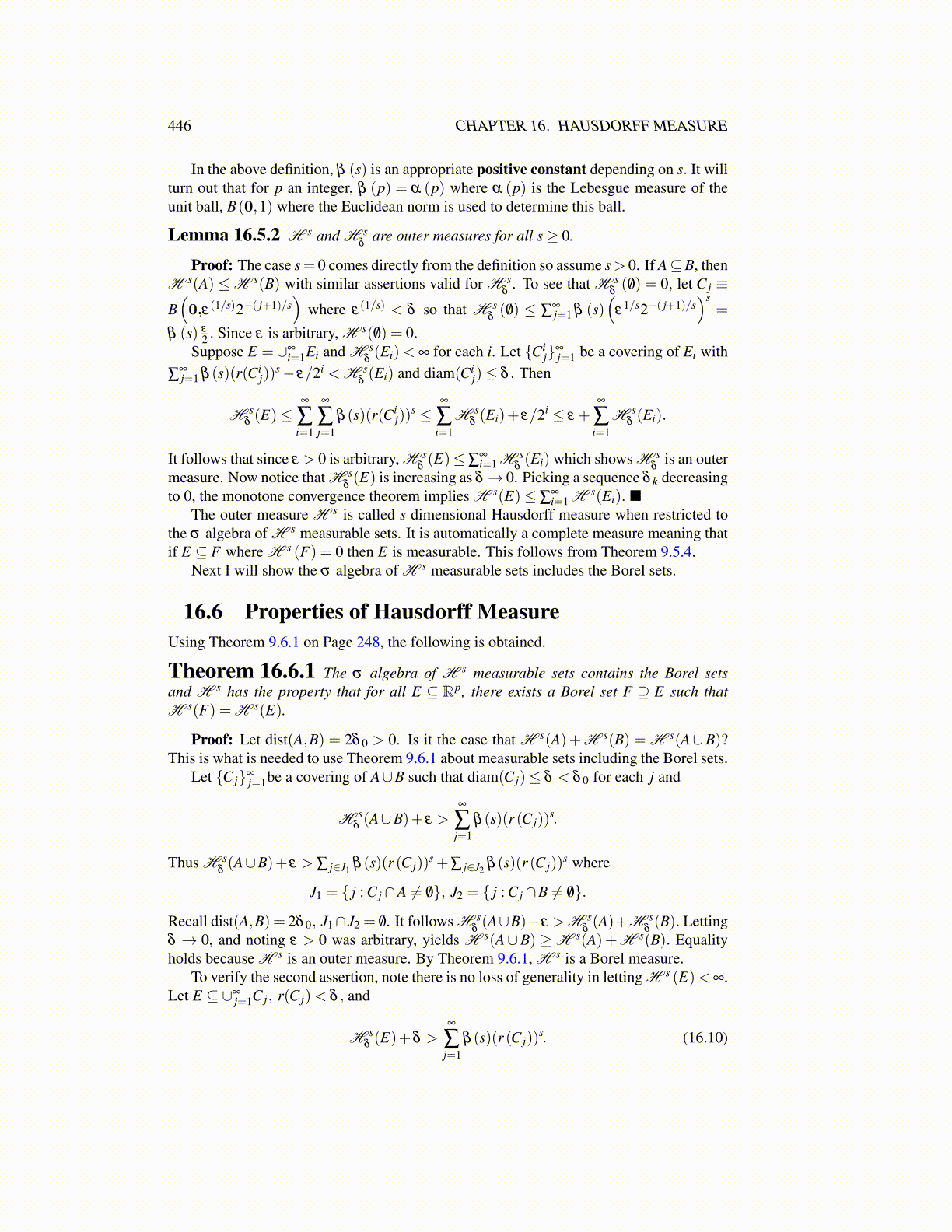
446 CHAPTER 16. HAUSDORFF MEASURE
In the above definition, β (s) is an appropriate positive constant depending on s. It willturn out that for p an integer, β (p) = α (p) where α (p) is the Lebesgue measure of theunit ball, B(0,1) where the Euclidean norm is used to determine this ball.
Lemma 16.5.2 H s and H sδ
are outer measures for all s≥ 0.
Proof: The case s= 0 comes directly from the definition so assume s> 0. If A⊆B, thenH s(A) ≤H s(B) with similar assertions valid for H s
δ. To see that H s
δ( /0) = 0, let C j ≡
B(0,ε(1/s)2−( j+1)/s
)where ε(1/s) < δ so that H s
δ( /0) ≤ ∑
∞j=1 β (s)
(ε1/s2−( j+1)/s
)s=
β (s) ε
2 . Since ε is arbitrary, H s( /0) = 0.Suppose E = ∪∞
i=1Ei and H sδ(Ei)< ∞ for each i. Let {Ci
j}∞j=1 be a covering of Ei with
∑∞j=1 β (s)(r(Ci
j))s− ε/2i < H s
δ(Ei) and diam(Ci
j)≤ δ . Then
H sδ(E)≤
∞
∑i=1
∞
∑j=1
β (s)(r(Cij))
s ≤∞
∑i=1
H sδ(Ei)+ ε/2i ≤ ε +
∞
∑i=1
H sδ(Ei).
It follows that since ε > 0 is arbitrary, H sδ(E)≤∑
∞i=1 H s
δ(Ei) which shows H s
δis an outer
measure. Now notice that H sδ(E) is increasing as δ → 0. Picking a sequence δ k decreasing
to 0, the monotone convergence theorem implies H s(E)≤ ∑∞i=1 H s(Ei). ■
The outer measure H s is called s dimensional Hausdorff measure when restricted tothe σ algebra of H s measurable sets. It is automatically a complete measure meaning thatif E ⊆ F where H s (F) = 0 then E is measurable. This follows from Theorem 9.5.4.
Next I will show the σ algebra of H s measurable sets includes the Borel sets.
16.6 Properties of Hausdorff MeasureUsing Theorem 9.6.1 on Page 248, the following is obtained.
Theorem 16.6.1 The σ algebra of H s measurable sets contains the Borel setsand H s has the property that for all E ⊆ Rp, there exists a Borel set F ⊇ E such thatH s(F) = H s(E).
Proof: Let dist(A,B) = 2δ 0 > 0. Is it the case that H s(A)+H s(B) = H s(A∪B)?This is what is needed to use Theorem 9.6.1 about measurable sets including the Borel sets.
Let {C j}∞j=1be a covering of A∪B such that diam(C j)≤ δ < δ 0 for each j and
H sδ(A∪B)+ ε >
∞
∑j=1
β (s)(r (C j))s.
Thus H sδ(A∪B)+ ε > ∑ j∈J1
β (s)(r (C j))s +∑ j∈J2
β (s)(r (C j))s where
J1 = { j : C j ∩A ̸= /0}, J2 = { j : C j ∩B ̸= /0}.
Recall dist(A,B) = 2δ 0, J1∩J2 = /0. It follows H sδ(A∪B)+ε >H s
δ(A)+H s
δ(B). Letting
δ → 0, and noting ε > 0 was arbitrary, yields H s(A∪B) ≥H s(A)+H s(B). Equalityholds because H s is an outer measure. By Theorem 9.6.1, H s is a Borel measure.
To verify the second assertion, note there is no loss of generality in letting H s (E)< ∞.Let E ⊆ ∪∞
j=1C j, r(C j)< δ , and
H sδ(E)+δ >
∞
∑j=1
β (s)(r (C j))s. (16.10)